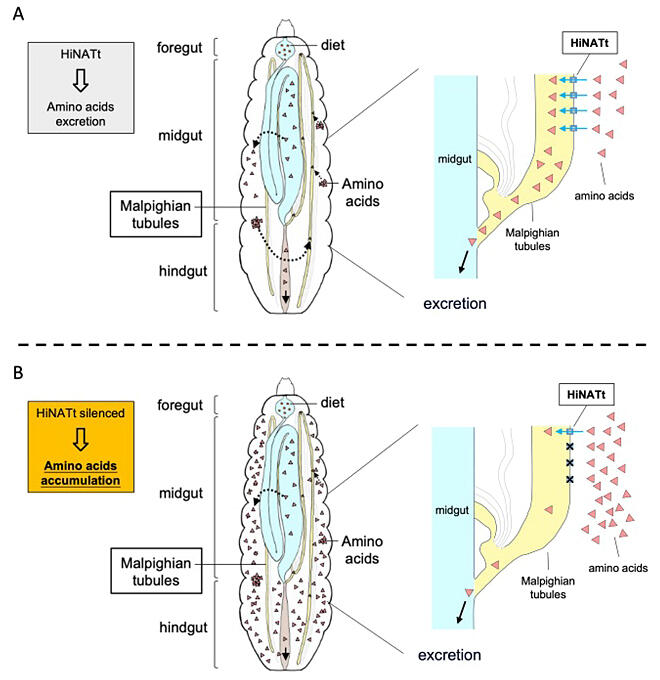A research group including Researcher Chia-Ming Liu and Senior Researcher Takuya Uehara of the Division of Insect Advanced Technology, Institute of Agrobiological Sciences at the National Agriculture and Food Research Organization (NARO), and Professor Masami Shimoda of the Graduate School of Agricultural and Life Sciences at the University of Tokyo, has announced that they developed a technology for high-level accumulation of essential amino acids, which were insufficient as feed, in an insect for feed use (black soldier fly). By inhibiting "HiNATt," one of the transporter genes that transport amino acids in the body to the digestive tract, they succeeded in increasing the total amount of amino acids in the body by 1.8-fold, and in particular, increasing the amount of histidine, an essential amino acid that was lacking in insects for feed use, by up to 2.9-fold. The findings are expected to contribute to a stable food supply and sustainable food production through resource recycling. The results were published in the November 1 issue of Journal of Insects as Food and Feed, an international journal.

Provided by NARO
As the world's population grows, the increasing demand for a protein supply is required to be addressed. There are high expectations for the expansion of marine aquaculture, which leaves room for increased production. Meanwhile, fishmeal, a raw material for animal feed, is in short supply internationally, and its price has skyrocketed 5-fold in the past 25 years. Fishmeal accounts for about 40% of formula feed for aquaculture, and Japan heavily depends on imports for fishmeal.
From this background, black soldier fly larvae, which can be produced using organic wastes such as food and agricultural residues as feed, are attracting attention as a protein source to replace fishmeal for feed use in poultry farming and aquaculture. The black soldier fly (Hermetia illucens) is an insect measuring 15-20 mm long (adult) in the family Stratiomyidae of the order Diptera. It was introduced to Japan around 1950 and reproduces naturally there. The larvae feed on decaying organic matter such as grass, fruit, animal carcasses, and feces. Black soldier flies do not sting humans or animals.
The research group has previously reported that intestinal bacterial flora in black soldier fly larvae fed on food residues suppress the odor of food residues. They have been conducting research and development for the practical use of the black soldier fly as an insect for feed use. Meanwhile, the essential amino acid composition of black soldier fly larvae differs from that of fishmeal. A lower content of histidine, one of the essential amino acids required for aquaculture, has been an issue.
In this study, the research group aimed to accumulate histidine in black soldier fly larvae by suppressing excretion function to increase the amount of histidine in the larvae. First, they used a next-generation sequencer to search for nutrient amino acid transporters (NATs), which transport amino acids in the insect body. NATs are found in various organs and play different functions. Five different NATs were discovered.
The research group examined the genome sequences and expression sites of these NATs and found a NAT that was expressed only in the Malpighian tubules, which constitute a part of the digestive tract. They named this transporter HiNATt. The Malpighian tubules serve as excretory organs like the kidneys. Amino acids in the insect's body are taken up into the Malpighian tubules across the cell membrane by the action of HiNATt, and they are sent to the hindgut before excretion.
RNA interference of the HiNATt gene to inhibit the excretion of amino acids showed a decrease in the expression level to 40%. One week after RNA interference treatment, the total amino acid level in black soldier fly larvae increased 1.8-fold. They examined the changes in the content of each amino acid due to RNA interference treatment. Histidine was found to be increased by a maximum of 2.9-fold, which suffices the required amount. In addition, methionine was increased up to 2.9-fold, and other essential amino acids were also increased, albeit the increases were not as much as those of histidine and methionine. They also confirmed that the black soldier fly larvae with total amino acid increases by RNA interference treatment were capable of normal eclosion.
Moving forward, the research group aims to produce black soldier fly strains for practical use and investigate the role of histidine and other amino acids in the black soldier fly.
Liu said, "This study paves the way to producing highly valuable black soldier fly strains as raw materials for feed. We are already working on breeding to obtain superior black soldier fly strains and improving feeding techniques. We will pursue research toward the practical use of insects as feed materials, aiming at stable food supply and sustainable food production with reduced environmental impact."
Journal Information
Publication: Journal of Insects as Food and Feed
Title: Enhancing the nutritional value of black soldier fly larvae through the nutrient amino acid transporter suppression in the excretion system
DOI: 10.1163/23524588-00001155
This article has been translated by JST with permission from The Science News Ltd. (https://sci-news.co.jp/). Unauthorized reproduction of the article and photographs is prohibited.




